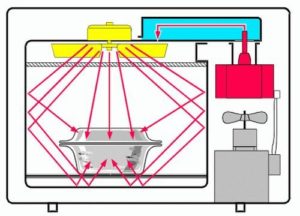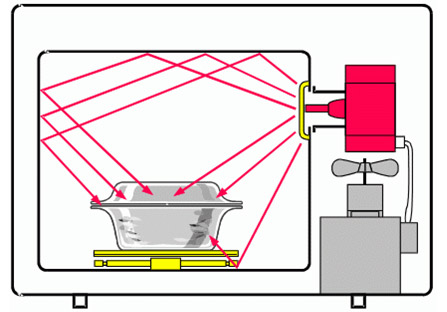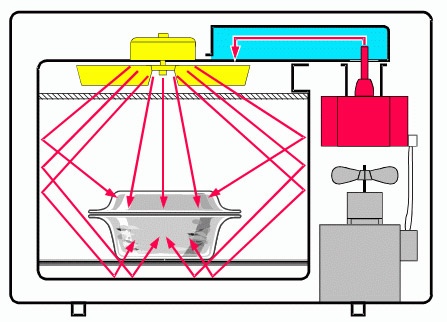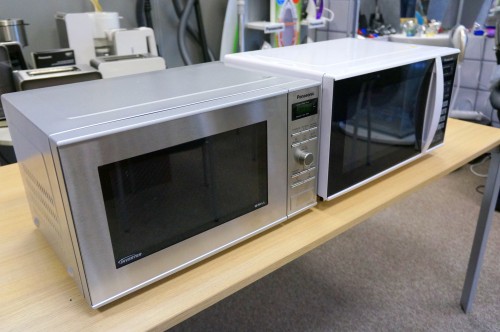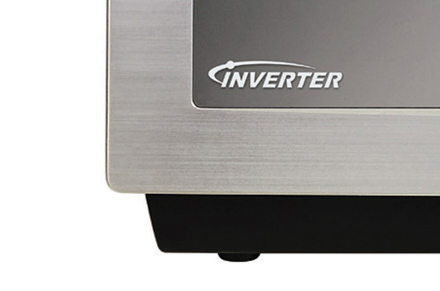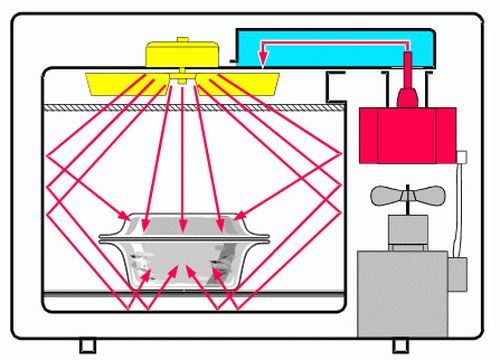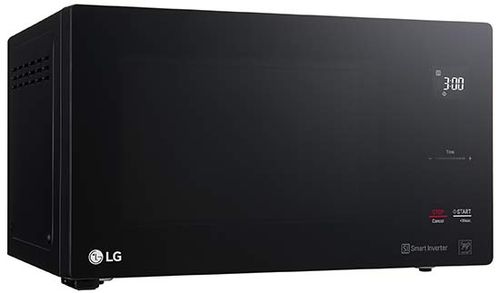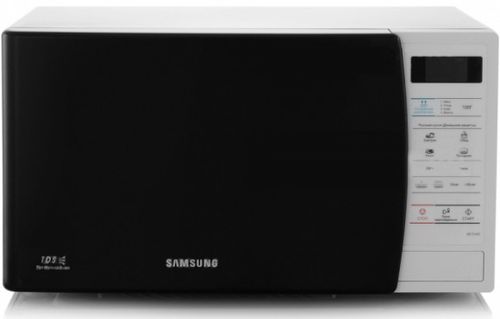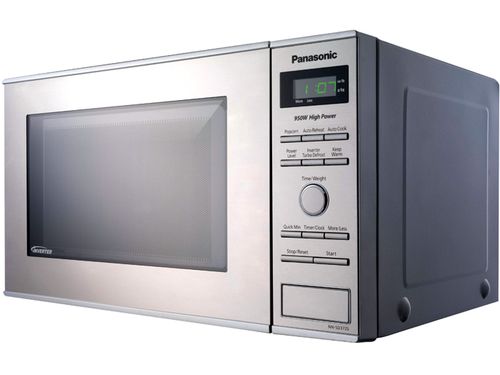Saving electricity
At first, the claim that an inverter microwave saves energy seems a little strange - after all, it works all the time, while a non-inverter one works intermittently. We explain: the inverter, although it works constantly, but, as a rule, gradually reduces the power of microwaves (and hence the amount of electricity consumed). In addition, the magnetron is turned on here only once - at the start of the cooking process. In a non-inverter furnace, the magnetron works intermittently, but always at the maximum (installed) power - as a result, more electricity is spent. Constant inclusions also add waste - at these moments the furnace consumes the maximum possible electricity.
The inverter is an important part of the microwave
As you might guess from the name, a feature of the novelty is the presence of an inverter in it. Some device that was missing in past models of microwave devices.
What is an inverter
To understand what it is, let's remember how a microwave oven works in general and what it consists of.
The operation of the device is based on the use of microwave radiation. In other words, electromagnetic waves or microwaves. Repeatedly reflected from the inner walls of the oven, they pass through the processed products. At the same time, heat energy is imparted to the water molecules contained in the food. Due to this, the food is warmed up.
The source of electromagnetic radiation in the furnace is the magnetron. It is located at the back of the microwave. Therefore, it is not visible unless the device is disassembled.
And the inverter is an element that controls and regulates the operation of the magnetron. In earlier and familiar models, this was done by a transformer.
What is the difference between the two electronic control units
- The first broadcasts only waves of a certain given power. His work is an alternation of short-term electromagnetic impulses and pauses.
- Inverter control is able to smoothly change the radiation power from a larger value to a smaller one. That is, it constantly generates microwaves, smoothly adjusting their strength during the session.
The principle of operation of the inverter in the microwave
In relation to the operation of the microwave, this means the following. A standard microwave oven always uses fixed power wave shocks. At the same time, it does not work continuously, alternating electric wave impulses with pauses. Different regimes differ only in the duration of impacts and breaks between them.
It is because of this unevenness that small local "explosions" and "accidents" occur in the microwave oven, causing food to splatter on the inside of the case. Experts say that damage occurs at the molecular level. As a result, the products lose some of their taste and nutritional properties.
The impact of the inverter microwave on food occurs constantly and evenly. The power of electromagnetic radiation decreases smoothly and gradually. Thanks to this, it is possible to set up more complex cooking modes. Maintain the integrity of products, including at the micro level, as well as their appearance.
For different models, specific figures are somewhat different, but on average, the savings are about 28 percent.
Thus, although outwardly inverter models look similar to the options we are more familiar with, inside they are quite different.
Fundamentals of the basics
To begin with, it is logical to give a few fundamental definitions. So, a microwave oven is an electrical food preparation appliance that uses the effect of heating materials (products) containing water by exposing them to electromagnetic waves of the decimeter range (most often with a frequency of 2450 MHz). Molecules of food, liquid, contain negative and positive particles. In the absence of an electromagnetic field, the molecules are randomly oriented. When cooking, under the influence of an alternating field, the molecules begin to rotate. As a result of molecular friction, heat is generated, which cooks food and causes water to boil.The heating of products here, in a microwave oven (it is also called a microwave oven; microwave - microwave radiation, in this context - the same as microwave radiation), occurs not only from the surface (from above), but also by the volume of the product containing polar molecules of liquid (water). Radio waves penetrate the product to a depth of about 2-3 cm and are absorbed by it. We especially note that there is no “heating from the inside” in the microwave oven - you can often hear such a statement. No, microwaves go exactly from outside to inside. The effect of "internal heating" can occur when processing products with dry, non-conductive surfaces in a microwave oven. For example, bakery products with a dried crust. In them, most of the moisture is concentrated inside. Therefore, heating manifests itself deeper - hence the opinion of "warming up from the inside." In everyday life, microwave ovens are used for quick preparation of various dishes, and often for quick defrosting or heating of food.
The magnetron is an indispensable element of the microwave oven. It is he who generates electromagnetic radiation, with the help of which food is cooked. The transformer (also part of the furnace design) provides the magnetron with high voltage power. Microwaves are fed into the working chamber passing through the waveguide (special channel), which just in the working chamber ends with an outlet channel (hole) transparent to radio frequencies. You should not turn on the microwave oven empty, because then the waves will not be absorbed by the product, but will be reflected from the walls of the working chamber, which can eventually cause sparking. Long sparking can damage the magnetron (so if a small amount of food is cooked in the “microwave”, it is advisable to put another glass of water in the chamber to absorb microwaves). There are microwave ovens with several waveguides - for a more even distribution of microwaves throughout the working chamber. There are also models in which the magnetron is installed in the bottom of the furnace (and not on the side, as in the vast majority of models). In this case, again, for a better distribution of radiation throughout the oven chamber, the microwave distributor rotates, which can be located in the working chamber from below or above.
Finally, the inverter microwave oven is the main character of this article. The main difference between an inverter microwave oven and a “conventional” one is the presence of an electronic power control unit for the magnetron (in fact, an inverter is a device for converting direct electric current into alternating current). And no transformer. Details of the microwave inverter power control are discussed below. The fact that the furnace does not have a transformer allows us to highlight some of this lack of advantages. Firstly, the electronic control unit takes up much less space - because of this, if we compare furnaces with the same volume of the working chamber, the dimensions of the non-inverter one will be somewhat larger.

Resume ZOOM.CNews
The disadvantage of inverter microwave ovens, by and large, is one - a slightly higher cost compared to non-inverter ones. However, the price difference has narrowed in recent years. A few years ago, it could reach up to 50% and even be higher (depending on the model). Now, for example, the difference between the cost of the models participating in the experiment is only about 1 thousand rubles (the inverter Panasonic NN-GD392S will cost about 5.5 thousand rubles *, and the non-inverter NN-GT352W - in the amount of about 4.5 thousand rubles) .
For the rest, we agree with the famous chef Alexander Seleznev - you should not expect incredible culinary miracles from an inverter oven.But she proved by experience that she cooks, let's say, smarter - products, dishes from this "smarter", as we have seen, are prepared, basically, with better quality. At the same time, you don’t need to spend any special effort for this (that is, to prepare them in some special way - we didn’t prepare very much during the test). Much less chance of overdrying. Less chance of loss of product shape. Plus, vitamins are better preserved from partially sparing, in fact, microwave treatment. Add to this the space savings in the kitchen. Saving electricity.
We thank Panasonic for their help in preparing the material.
8 790
rub.
30%
RUB 12,499
Microwave solo LG MS2595GIH
Pallet diameter 292 mm. Management is electronic. With automatic preparation. The inner coating of the chamber is enamel. Maximum microwave power 1000W. . With display. With automatic heating. With defrost mode. White colour. Opening the door - handle. With system of uniform distribution of microwaves. Volume 25 l. With camera light. With an audible shutdown signal. With automatic defrost. Dimensions 27x48x37 cm.
About the benefits
In addition to small dimensions, inventory furnaces have the following advantages:
- Uniform heating of the product.
- Multifunctionality.
- Fast defrost capability.
- The absence of a round rotating plate.
When choosing inverter microwaves Panasonic, Samsung, LG, you need to pay attention to the power of the model. If you plan to use the device rarely, a low-power oven, rated at only 600 W, is quite suitable.
More functional options intended for frequent use should have a power of at least 1500 watts.
Panasonic inverter microwave, may have a different volume. The small-sized model is designed for 14 liters, the voluminous and capacious model is designed for 20 liters or more. The latter option is suitable for large families or hostesses who regularly organize parties and home gatherings.
When studying what kind of inventory technology it is, do not forget to pay attention to the furnace control option. The LG inverter microwave can be equipped with one of two control options:
- Electronic;
- Touch.
Microwave inverter control is a technology that offers a wide range of functions and options in each model. So most inventory ovens are equipped with a grill function. Moreover, this process can be carried out by a heating element or a quartz lamp. In the presence of a quartz element, an appetizing crust is formed on the products, reminiscent of a dish cooked on a fire. Some models of Panasonic inventory microwaves can be equipped with two types of grill.

